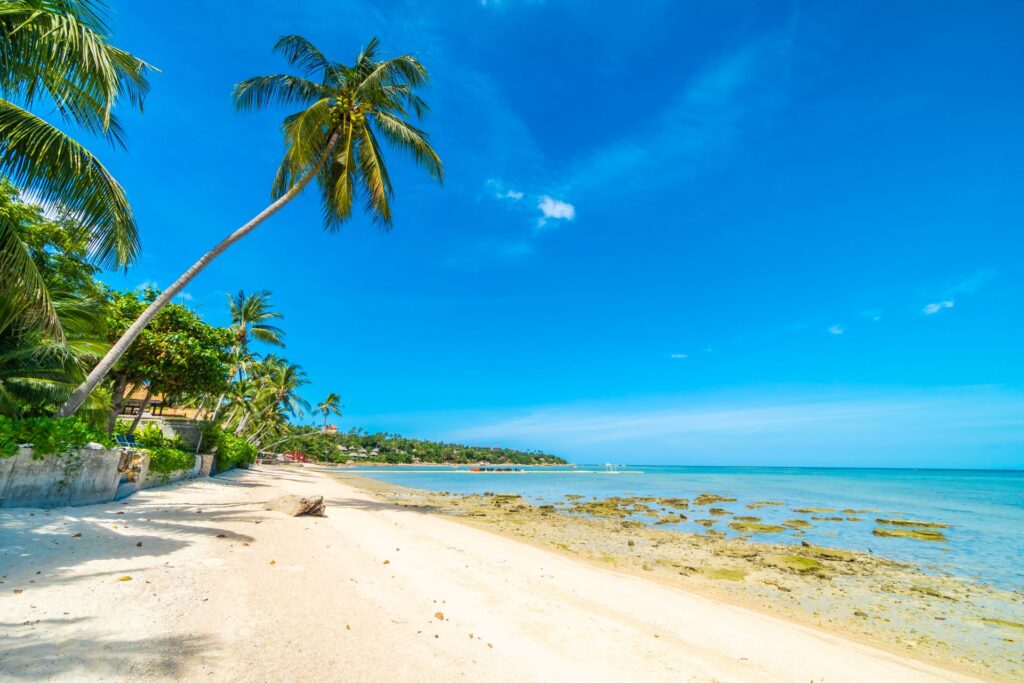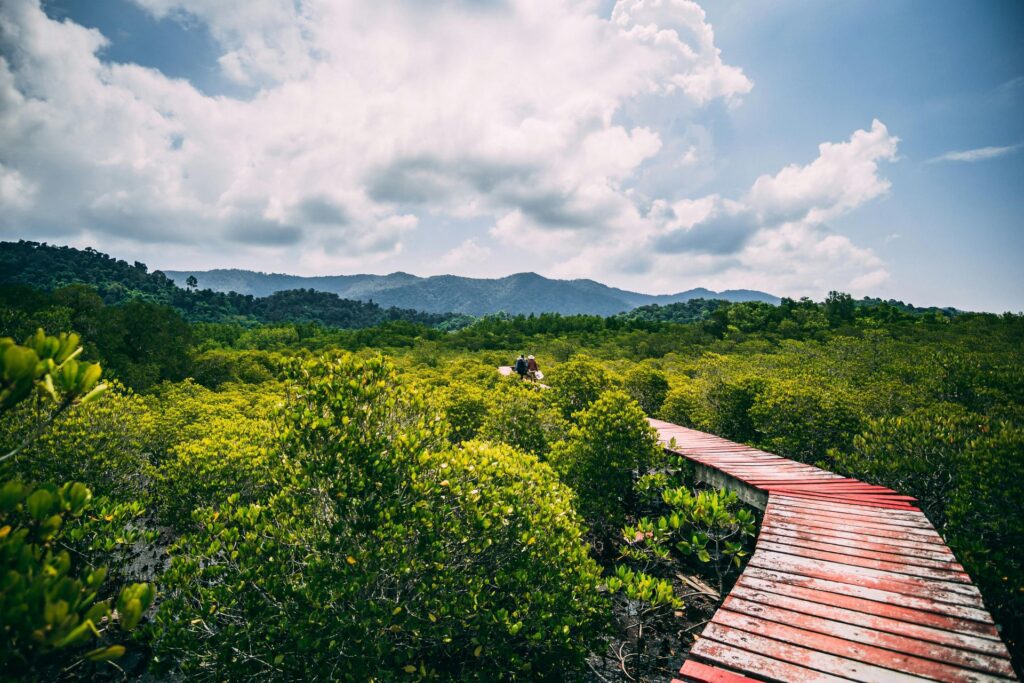Koh Samui, one of Thailand’s most famous islands, is celebrated for its beautiful beaches, lush tropical scenery, and consistently warm climate. But whether you’re living on or visiting this island paradise, it’s important to understand its unique weather patterns and prepare for the seasonal variations. Koh Samui’s climate is distinctly tropical, characterized by a mix of hot, rainy, and dry periods throughout the year. Knowing what to expect—and how to adapt to these changes—will ensure you make the most of your time here, whether you’re relaxing on the beach or navigating through a monsoon rain.
In this article, we’ll explore the details of Koh Samui’s climate, pinpoint the best times to visit, and offer practical tips on how to comfortably adapt to the changing seasons.
Overview of Koh Samui’s Climate
Koh Samui enjoys a tropical monsoon climate, which means warm to hot temperatures year-round, along with distinct wet and dry seasons. The island’s weather can be divided into three main periods: the hot season, the rainy season, and the dry season. Koh Samui’s tropical location ensures that temperatures remain fairly consistent, generally ranging between 25°C to 35°C (77°F to 95°F) throughout the year, with high humidity. While the island enjoys plenty of sunshine, seasonal changes bring variations in both rainfall and temperature, creating different experiences for visitors and residents alike.
The Hot Season (March to June)
The hot season in Koh Samui typically runs from March to June, making it the warmest time of year on the island. During this period, temperatures frequently reach up to 35°C (95°F) or higher, accompanied by high humidity levels. While this season offers plenty of sunshine, the heat can be intense, especially for those not accustomed to tropical climates.
What to Expect During the Hot Season
During the hot season, you can expect long, sunny days with minimal rainfall. It’s the perfect time for enjoying Koh Samui’s beaches, swimming, snorkeling, and other water-based activities. However, the heat and humidity can be quite overwhelming, especially during the afternoons when temperatures peak. Despite this, the clear skies and warm ocean make it an attractive time to visit for sunseekers.
How to Adapt to the Hot Season
To comfortably handle the hot season, it’s important to take certain precautions. Wear light, breathable clothing, preferably made from cotton or linen, to stay cool. Staying hydrated is crucial, so always carry water with you, especially if you plan on outdoor activities. Avoid prolonged exposure to direct sunlight, particularly during midday when temperatures are highest. Sunscreen is a must to prevent sunburn, and many people opt to relax in the shade or take frequent dips in the sea or a pool to cool down.
For those living on the island or staying for an extended period, air conditioning is a welcomed relief from the heat, and planning outdoor activities in the early morning or late afternoon can help you avoid the hottest hours.

The Rainy Season (October to December)
Koh Samui’s rainy season typically occurs between October and December, when the island experiences its highest levels of rainfall. The season is influenced by the northeast monsoon, which brings heavy downpours, thunderstorms, and strong winds. While the rain can be frequent, temperatures remain warm, making it a tropical and humid season rather than a cold one. The rains are usually intense but short, and the island remains lush and vibrant.
What to Expect During the Rainy Season
During the rainy season, it’s common to experience heavy rain showers that can last for several hours, especially in the late afternoon and evenings. The rain may be accompanied by thunderstorms and strong winds, and in some areas, flooding may occur, especially in low-lying regions. Despite this, you’ll often get a mix of weather, with sunny intervals between rain showers. Outdoor activities like beach trips and water sports may be interrupted, but the island’s natural beauty remains a sight to behold during and after the rain.
How to Adapt to the Rainy Season
To make the most of your time in Koh Samui during the rainy season, be prepared for sudden downpours by carrying an umbrella or raincoat. It’s also a good idea to check the weather forecast daily and plan outdoor activities around the rain. Indoor activities such as spa treatments, cooking classes, and shopping can be enjoyable alternatives when the rain comes. Additionally, choose accommodations that are well-equipped to handle tropical storms, with good drainage and storm protection, especially if you’re staying near the beach or in areas prone to flooding.

The Dry Season (January to March)
The dry season in Koh Samui, which runs from January to March, is often regarded as the best time to visit the island. During this period, the weather is more temperate, with cooler temperatures and minimal rainfall. It’s the ideal season for outdoor activities, with clear skies, mild sea conditions, and gentle breezes. The dry season is also peak tourist season, as visitors from around the world flock to Koh Samui to enjoy the perfect tropical weather.
What to Expect During the Dry Season
During the dry season, temperatures typically range between 25°C to 30°C (77°F to 86°F), with low humidity compared to the hot and rainy seasons. The skies are clear, and there’s little to no rain, making it the perfect time for beach lovers and adventurers. Swimming, snorkeling, hiking, and sunbathing are at their best during these months, as the seas are calm and the weather is consistent. However, since it’s peak season, popular beaches and tourist spots can get crowded.
How to Adapt to the Dry Season
While the dry season brings cooler temperatures, it’s still important to take steps to protect yourself from the sun. Wear light, breathable clothing, a hat, and sunglasses to stay comfortable while exploring the island. Don’t forget to apply sunscreen regularly, as the UV index remains high. Staying hydrated is essential, especially if you’re engaging in outdoor activities. The dry season is also the perfect time to take full advantage of Koh Samui’s natural beauty, so be sure to pack for activities like snorkeling, hiking, and exploring the island’s waterfalls.
Adapting to Koh Samui’s Humidity
One of the defining features of Koh Samui’s tropical climate is its consistently high humidity, which can range from 70% to 90% throughout the year. Whether you’re visiting during the hot season or the rainy season, the humidity can make the air feel warmer than it actually is. While the refreshing sea breeze offers some relief, learning how to manage the humidity is key to staying comfortable.
How to Handle High Humidity
To cope with the high humidity in Koh Samui, it’s important to dress in light, moisture-wicking fabrics like cotton, linen, or bamboo. These materials allow your skin to breathe, helping you stay cooler and drier throughout the day. At home or in your accommodation, ensure there’s good ventilation or use air conditioning to keep indoor spaces cool and reduce the moisture in the air. Staying hydrated is essential—drink plenty of water throughout the day to avoid dehydration, which can happen quickly in such humid conditions. Taking cool showers can also help refresh your body and make you feel more comfortable when the humidity becomes overwhelming.

Best Time to Visit Koh Samui
Though Koh Samui is an appealing destination year-round, the dry season from January to March is generally regarded as the best time to visit. During this period, you’ll experience clear skies, mild temperatures, and minimal rainfall—ideal conditions for enjoying the island’s beaches, outdoor activities, and crystal-clear waters. This is the perfect season for travelers seeking sunny days for snorkeling, hiking, or simply lounging by the beach. However, it’s also the island’s peak tourist season, meaning that popular areas may be busier, and accommodation prices can be higher.
For those who prefer a quieter experience, visiting during the rainy season (October to December) offers a more peaceful atmosphere, with fewer crowds and potentially lower rates at hotels and resorts. While you’ll experience more rain showers, the island’s natural beauty remains, and there are plenty of indoor activities and wellness options to enjoy. Ultimately, the best time to visit Koh Samui depends on your preferences and the type of vacation experience you’re looking for—whether it’s sunny days on the beach or a serene retreat during the rain.
Conclusion
Koh Samui’s tropical climate is a major draw for visitors, but adapting to its seasonal variations is key to enjoying your time on the island. Whether you’re basking in the warm sunshine of the dry season, staying cool during the hot season, or navigating the tropical downpours of the rainy season, each period offers a unique experience. Understanding the island’s weather patterns and knowing how to prepare—by dressing appropriately, staying hydrated, and adjusting to the high humidity—will ensure you make the most of your stay. With its beautiful beaches and tropical charm, Koh Samui is a year-round destination, and with the right preparation, you’ll be able to enjoy the island’s natural beauty no matter when you visit.

FAQs About the Climate in Koh Samui
The best time to visit is during the dry season, from January to March, when the weather is cooler, and there is minimal rainfall.
Temperatures can reach up to 35°C (95°F) during the hot season, particularly from March to June.
Yes, the rainy season, influenced by the northeast monsoon, typically occurs from October to December, bringing heavy rain and occasional thunderstorms.
Yes, although the rainy season brings more showers, you can still enjoy many activities. Just be prepared for some wet weather and occasional flooding in low-lying areas.
Light, breathable clothing, sunscreen, a hat, and plenty of water are essential for staying comfortable during the hot season.
Wearing moisture-wicking fabrics, staying hydrated, and using air conditioning or fans can help you manage the humidity.
The average temperature ranges from 25°C to 35°C (77°F to 95°F), depending on the season.
While Koh Samui is warm year-round, the dry season (January to March) offers slightly cooler temperatures, making it more comfortable for outdoor activities.
No, rain showers are often short but heavy, and you can still expect sunny intervals between downpours.
Swimming is generally safe, but it’s best to check local weather conditions, as strong winds or currents may occur during heavy rains.

